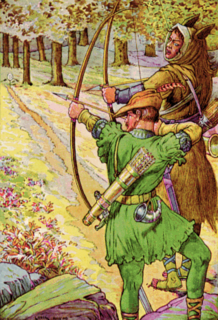 W
WEuropean folklore or Western folklore refers to the folklore of the Western world, especially when discussed comparatively. The history of Christendom during the European Middle Ages and the Early Modern period has resulted in a number of traditions that are shared in many European ethnic and regional cultures.
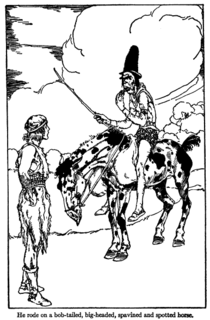 W
WAdventures of Gilla Na Chreck An Gour is an Irish fairy tale collected by folklorist Patrick Kennedy and published in Legendary Fictions of the Irish Celts (1866). The tale was also published by Irish poet Alfred Perceval Graves in his Irish Fairy Book (1909). Joseph Jacobs published the tale as The Lad with the Goat-Skin in his Celtic Fairy Tales.
 W
WAn Alp is a supernatural being in German folklore.
 W
WAnkou is a servant of death in Breton, Cornish, Welsh and Norman French folklore.
 W
WThe symbol of a bluebird as the harbinger of happiness is found in many cultures and may date back thousands of years.
 W
WA castell is a human tower built traditionally at festivals in Catalonia, the Balearic islands and the Valencian Community. At these festivals, several colles castelleres attempt to build and dismantle a tower's structure. On 16 November 2010, castells were declared by UNESCO to be amongst the Masterpieces of the Oral and Intangible Heritage of Humanity.
 W
WA changeling, also historically referred to as an auf or oaf, is a human-like creature found in folklore and folk religion throughout Europe. A changeling was believed to be a fairy that had been left in place of a human stolen by the fairies.
 W
WCorpse roads provided a practical means for transporting corpses, often from remote communities, to cemeteries that had burial rights, such as parish churches and chapels of ease. In Britain, such routes can also be known by a number of other names, e.g.: bier road, burial road, coffin line, coffin road, corpse way, funeral road, lych way, lyke way, or procession way. etc. Such "church-ways" have developed a great deal of associated folklore regarding ghosts, spirits, wraiths, etc.
 W
WDevil's Bridge is a term applied to dozens of ancient bridges, found primarily in Europe. Most of these bridges are stone or masonry arch bridges and represent a significant technological achievement in ancient architecture. Due to their unusual design, they were an object of fascination and stories in antiquity and medieval Europe.
 W
WEglė the Queen of Serpents, alternatively Eglė the Queen of Grass Snakes, is a Lithuanian folk tale, first published by M. Jasewicz in 1837.
 W
WDuring the Middle Ages in Europe, Egyptian days were certain days of the year held to be unlucky. The Egyptian days were:January 1, 25 February 4, 26 March 1, 28 April 10, 20 May 3, 25 June 10, 16 July 13, 22 August 1,30 September 3, 21 October 3, 22 November 5, 28 December 7, 22
 W
WElegast is the hero and noble robber in the poem Karel ende Elegast, an early Middle Dutch epic poem that has been translated into English as Charlemagne and Elbegast. In the poem, he possibly represents the King of the Elves. He appears as a knight on a black horse, an outcast vassal of Charlemagne living in the forest. The original Dutch poem uses the name Elegast, while translated versions of the poem commonly use the name Elbegast in German and English, or Alegast in the Scandinavian ballad.
 W
WElucidarium is an encyclopedic work or summa about medieval Christian theology and folk belief, originally written in the late 11th century by Honorius Augustodunensis, influenced by Anselm of Canterbury and John Scotus Eriugena. It was probably complete by 1098, as the latest work by Anselm that finds mention is Cur deus homo. This suggests that it is the earliest work by Honorius, written when he was a young man. It was intended as a handbook for the lower and less educated clergy. Valerie Flint (1975) associates its compilation with the 11th-century Reform of English monasticism.
 W
WA fairy ring, also known as fairy circle, elf circle, elf ring or pixie ring, is a naturally occurring ring or arc of mushrooms. They are found mainly in forested areas, but also appear in grasslands or rangelands. Fairy rings are detectable by sporocarps in rings or arcs, as well as by a necrotic zone, or a ring of dark green grass. Fungus mycelium is present in the ring or arc underneath. The rings may grow to over 10 metres (33 ft) in diameter, and they become stable over time as the fungus grows and seeks food underground.
 W
WThe Festivity of La Mare de Déu de la Salut is a festival celebrated in Algemesí, Spain, from August 29 to September 8. The festival is in honour of the patron saint of Algemesí, La Mare de Déu de la Salut, and has been dated back to 1247. The holiday was awarded the UNESCO "Masterpieces of the Oral and Intangible Heritage of Humanity" designation on November 28, 2011.
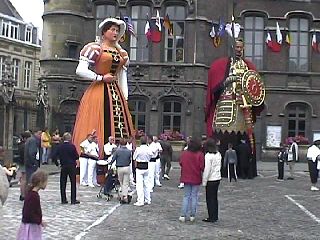 W
WGayant the giant is the symbol of Douai. Each year for three days at the beginning of July, the Gayant festival takes place. The Gayant family, composed of the giant's wife Marie Cagenon and their three children, Jacquot, Fillon and Binbin, are carried through the city. On Sunday the largest procession starts from the town hall. Gayant is registered with the Masterpieces of the Oral and Intangible Heritage of Humanity like member of Giants and processional dragons of Belgium and France.
 W
WGriselda is a figure in European folklore noted for her patience and obedience.
 W
WA Hand of Glory is the dried and pickled hand of a hanged man, often specified as being the left hand, or, if the person was hanged for murder, the hand that "did the deed."
 W
WThe Headless Horseman is a mythical figure who has appeared in folklore around the world since the Middle Ages. The figure is traditionally depicted as a man upon horseback who is missing his head.
 W
WHistoria von D. Johann Fausten, the first "Faust book", is a chapbook of stories concerning the life of Johann Georg Faust, written by an anonymous German author. It was published by Johann Spies (1540–1623) in Frankfurt am Main in 1587, and became the main source for the play The Tragical History of Doctor Faustus by Christopher Marlowe and Goethe's closet play Faust, and also served as the libretto of the opera by Alfred Schnittke, also entitled Historia von D. Johann Fausten.
 W
WThe International Society for Ethnology and Folklore is a professional association of scholars in the fields of ethnology, folklore studies, and cultural anthropology based in Amsterdam at the Meertens Institute. The goal of SIEF is to create professional networks between its scholars and their institutes and to stimulate research in general. To accomplish that every two years an international scholarly congress is organised and a General Assembly is held. Within its framework various special interest working groups are active: on cultural heritage, religion, rituality, cultural analysis, etc.
 W
WKing Lindworm or Prince Lindworm is a Danish fairy tale published in the 19th century by Danish folklorist Svend Grundtvig.
 W
WA kitchen witch, sometimes called a cottage witch or a "Scandinavian" kitchen witch doll, is a poppet or homemade doll resembling a stereotypical witch or crone displayed in residential kitchens as a good luck charm and to ward off bad spirits.
 W
WIn folklore, the lepus cornutus or horned hare is a type of hare or rabbit that in the 16th, 17th and 18th centuries was believed to exist, but is now considered to be fictional.
 W
WIn England, the Lord of Misrule – known in Scotland as the Abbot of Unreason and in France as the Prince des Sots – was an officer appointed by lot during Christmastide to preside over the Feast of Fools. The Lord of Misrule was generally a peasant or sub-deacon appointed to be in charge of Christmas revelries, which often included drunkenness and wild partying.
 W
WMaltese folklore is the folk tradition which has developed in Malta over the centuries, and expresses the cultural identity of the Maltese people. Maltese folklore, traditions and legends still live in the minds of the older-generations, and these are slowly being studied and categorized, like any other European tradition. A number of national and international folklore festivals are undertaken on an annual basis, some of which are under the patronage of the National Folklore Commission and the Ministry for Culture and the Arts. Notably, every December the Malta International Folk Festival is staged in Valletta, with delegates from countries around the World.
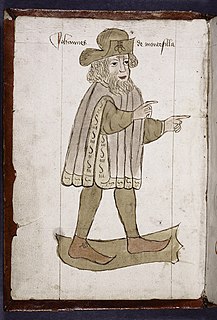 W
WSir John Mandeville is the supposed author of The Travels of Sir John Mandeville, a travel memoir which first circulated between 1357 and 1371. The earliest-surviving text is in French.
 W
WOsculum infame is the name of a witch's supposed ritual greeting upon meeting with the Devil. The name means The Shameful Kiss, or The Kiss of Shame since it involved kissing the devil's anus, his other mouth. According to folklore, it was this kiss that allowed the Devil to seduce women.
 W
WPerchtenlaufen is a folk custom found in the Tyrol region of central Europe. Occurring on set occasions, the ceremony involves two groups of locals fighting against one another using wooden canes and sticks. Both groups are masked, one as 'beautiful' and the other as 'ugly' Perchte.
 W
WA rat king is a collection of rats whose tails are intertwined and bound together by one of several possible mechanisms, such as entangling material like hair or sticky substances like sap or gum or getting tied together. Historically, this phenomenon is particularly associated with Germany. There are several specimens preserved in museums but very few instances of rat kings have been observed in modern times.
 W
WThe Red Jews, a legendary Jewish nation, appear in vernacular sources in Germany during the medieval era, from the 13th to the 15th centuries. These texts portray the Red Jews as an epochal threat to Christendom, one which would invade Europe during the tribulations leading to the end of the world.
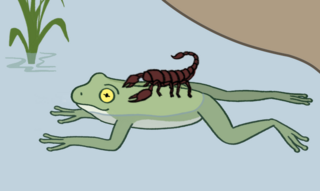 W
WThe Scorpion and the Frog is an animal fable which teaches that some people cannot resist hurting others even when it is not in their own interests. This fable seems to have emerged in Russia in the early 20th century.
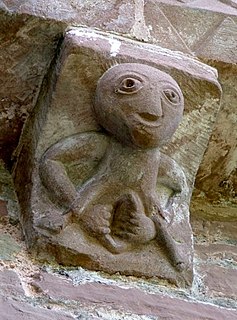 W
WSheela na gigs are figurative carvings of naked women displaying an exaggerated vulva. They are architectural grotesques found throughout most of Europe on cathedrals, castles, and other buildings. The greatest concentrations can be found in Ireland, Great Britain, France and Spain, sometimes together with male figures. Ireland has the greatest number of surviving sheela na gig carvings; Joanne McMahon and Jack Roberts cite 101 examples in Ireland and 45 examples in Britain. One of the best examples may be found in the Round Tower at Rattoo, in County Kerry, Ireland. There is a replica of the Round Tower sheela na gig in the County Museum in Tralee town. Another well-known example may be seen at Kilpeck in Herefordshire, England.
 W
WShooting an apple off one's child's head, also known as apple-shot is a feat of marksmanship with a bow that occurs as a motif in a number of legends in Germanic folklore. In the Stith Thompson Motif Index it is F661.3, described as "Skillful marksman shoots apple from man's head" or "apple shot from man's head", though it always occurs in the form of the marksman being ordered to shoot an apple off his own son's head. It is best known as William Tell's feat.
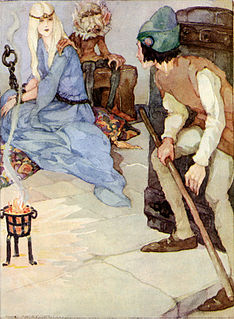 W
WStrong Hans is a German fairy tale collected by the Brothers Grimm and published in their collection as number KHM 166.
 W
WValentine and Orson is a romance which has been attached to the Carolingian cycle.
 W
WVenusberg is a motif of European folklore rendered in various legends and epics since the Late Middle Ages. It is a variant of the folktale topos of "a mortal man seduced by the fairy queen visits the otherworld". In German folklore of the 16th century, the narrative becomes associated with the minnesinger Tannhäuser who becomes obsessed with worshipping the goddess Venus.
 W
WThe Wandering Jew is a mythical immortal man whose legend began to spread in Europe in the 13th century. In the original legend, a Jew who taunted Jesus on the way to the Crucifixion was then cursed to walk the Earth until the Second Coming. The exact nature of the wanderer's indiscretion varies in different versions of the tale, as do aspects of his character; sometimes he is said to be a shoemaker or other tradesman, while sometimes he is the doorman at the estate of Pontius Pilate.
 W
WA White Lady is a type of female ghost, typically dressed in a white dress or similar garment, reportedly seen in rural areas and associated with local legends of tragedy. White Lady legends are found in many countries around the world. Common to many of these legends is an accidental death, murder, or suicide, and the theme of loss, betrayal by a husband or fiancée, and unrequited love.
 W
WIn folklore, a will-o'-the-wisp, will-o'-wisp or ignis fatuus, is an atmospheric ghost light seen by travelers at night, especially over bogs, swamps or marshes. The phenomenon is known in English folk belief, English folklore and much of European folklore by a variety of names, including jack-o'-lantern, friar's lantern, hinkypunk and hobby lantern and is said to mislead travelers by resembling a flickering lamp or lantern. In literature, will-o'-the-wisp metaphorically refers to a hope or goal that leads one on but is impossible to reach or something one finds sinister and weird.
 W
WA wishing well is a term from European folklore to describe wells where it was thought that any spoken wish would be granted. The idea that a wish would be granted came from the notion that water housed deities or had been placed there as a gift from the gods. This practice is thought to have arisen because water is a source of life, and was often a scarce commodity.